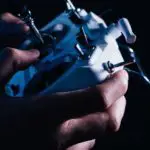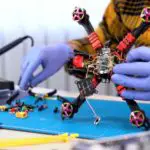We hate hearing the voltage alarm mid-flight. If you are scratching your head on how to improve flight time of your drone, be it for racing, freestyle or long range, you are at the right place. Here’re 11 tips to help your drone fly longer.

Shed Off Some Weight
The heavier your drone, the more power or thrust is required to lift it. Hence, reducing the payload can significantly improve the flight time of your drone. You could opt for the most obvious option: going with lighter components from battery, motors, and even bolt and nuts.
Given the battery is probably the heaviest component on your drone, you can achieve the biggest weight saving from it. For instance, the 4S XILO 1300 mAh is 9 g heavier than the AHTECH Infinity RS Force V2 despite having the same spec. The next thing to look at is the motors, as they are the second heaviest components.
It might be surprising, but even the smallest components which are the bolts and nuts can have their weight cut. By using titanium bolts and nuts instead of their steel counterparts, you save close to 50% of the weight.
Bear in mind that I am not asking you to choose a component based on the weight. Instead, you need to select the components based on the features or specs that suit your needs. Then, choose the lighter alternative without compromising the quality or functionality that you desire.
You should also consider minimizing the use of unnecessary accessories. For instance, do you really need the prop guards if you are flying outdoors? Or do you really need the LED stripes on your drone? If you don’t need them, stripe them off your drone.
Remember, every gram counts! While things like bolt and nut, LED and etc. might seem light and insignificant, they add up to make a sizable difference. The key is to reasonably cut as much weight as you can.
Pace Your Flight

Nothing drains a drone’s battery faster than going full throttle all the time. Flying at top speeds sure is a necessity, especially when you are planning to compete. Even if you aren’t competing, flying aggressively is thrilling.
However, if your main priority is trying to prolong the life of your battery or enjoy that quiet time that you have with yourself and your drone, then perhaps going easy on the throttle would serve you well for quite some time.
Accelerate smoothly and keep everything in the down-low. Avoid making sudden changes of speed or directions. By doing so, you will definitely extend the flight time of your drone!
Increase the Battery’s Capacity
Each battery has a labeled capacity measured in mAh which tells you how much juice the battery can offer. Increasing the battery’s capacity probably needs no explanation, as this is certainly the most obvious one to do when you want to extend the flight time of your drone.
Opting for a battery with greater capacity or higher mAh would provide you with a longer flight time… except that it is not always the case. An increase in capacity can also mean an increase in battery weight! If you are not careful, the extra juice added to your battery might just barely offset the increased weight, and doesn’t help you at all!
When you want to look for a battery with higher capacity to improve flight time, take a look at the energy density. Energy density is calculated by multiplying the voltage and capacity of the battery, divided by the weight. The higher the energy density, the more energy the battery stores per gram.
To bump up that flight time and extend that basking-in-the-sun moment of yours, the new batteries that you should choose are those with higher capacity and the same, if not higher energy density.
Do bear in mind that, by using a heavier battery, your drone will not be able to fly in a way it used to, due to the additional weight. It becomes more “sluggish”. If your main purpose is racing, increasing the battery capacity might not be a good idea.
I have compiled a list of best LiPo and things that you need to know when choosing LiPo batteries. Do check that out if you need to understand more about LiPo.
Don’t be Stingy with the C Rating of Your Battery
A battery’s C rating is a value that indicates the discharge rate of your battery. A battery with a higher C rating would reflect a higher maximum current output, and consequently, a higher level of power available for your motor to consume.
You might be thinking, by using a low C rating battery, the current draw will be lowered, and hence the battery will last longer, right? Wrong!
The amount of current draw depends on the motor. Even if your battery supports only up to 40 C, if required, your motors will draw current at 80 C. And that will severely damage your battery.
The main reason C rating comes into the picture is because of voltage sag. Voltage sag is a phenomenon where your battery voltage drops significantly when you push the throttle, and recovers slowly after you release the throttle.
Voltage sag is more apparent in batteries with a lower C rating. If you are using a low C rating battery, your voltage per cell will sag more and take longer time to recover. What that means is when you are flying a drone with a low C rating battery, you need to land earlier, because the voltage will drop to the minimum voltage at a faster rate.
Hence, using a high C rating battery can help you to fly longer to a certain extent. It might not be significant itself, but hey, every minute counts! Do note that batteries with a higher C rating might be slightly heavier.
Round out Your Battery Care
This is probably a more immersive topic than most, as there are thousands of ways to go about this tip. You should not fully deplete the battery, you should store it in appropriate containers, you should storage-charge every time when you want to store the battery – there are numerous pieces of advice out there that you could use to maintain your battery in its tip-top shape.
However, throughout all these, the basic point that you need to remember is that the capacity of your battery will always decrease over time, and that is an irrefutable fact. Do remember that maintenance could slow this decline, but replacing them when required is likewise a smart move.
Check out my LiPo battery care guide for tips on handling and caring LiPo batteries.

If you are flying long range, consider using Li-Ion batteries instead. See other long range tips here. Li-Ion batteries have higher energy density, which means they can store more energy per weight. However, it is not suitable for racing or freestyle because it has low C rating.
Use Efficient Motors
The biggest battery juice suckers are your motors. To fly longer, you need efficient motors that produce more thrust using the same amount of energy.
Efficiency is measured by thrust generated per watt required. The higher the value, the more efficient the motors. Subsequently, the lower the energy consumption.
Certain motors are more efficient at medium throttle while some are more efficient at full throttle. When you are looking into this stat, you should consider your flying habits and needs, so that you choose one that fits your play style.
Opt for Motors with Low Amp Draw
Motors with low amp draw suck your LiPo’s juice slower. As a result, you will get a longer flight time. Low amp motors typically have a smaller stator and have a lesser KV rating.
A motor with a smaller stator is lighter in weight for the obvious reason. However, you will get a slower acceleration. I guess that is acceptable, since your concern now is to prolong the flight time instead of flying faster.
In a layman’s term, KV tells you how many rotations the motor can produce per minute, per volt supplied. For instance, a motor with a KV of 2100 supplied with 4.2V runs roughly at 4.2 x 2100 = 8820 rpm. So, technically a motor with lower KV will spin slower than one with higher KV. And as a result, your drone flies slower.
When using motors with lower amp draw, you will notice your drone becomes less powerful. But if you just want to have a more relaxed flight instead of speed, motors with low amp draw is definitely something to look at.
Use Lower Pitch Props
The props of a drone serve as the points of generating thrust as they spin. The pitch of a propeller is the angle by which they are stationed, indicating whether a prop would produce more trust for each rotation.
While higher pitches usually result in greater top speeds and thrust, using props with high pitch is comparable to flying your drone in the “overdrive” mode consistently. It drains more power, and that’s bad if your main objective is not speed.
Lowering the pitch of your propellers would provide you with lower thrust and speeds, but it will manage your battery life relatively well, especially when the situation does not call for booming speeds anyway.
Go for Bigger Props
A larger prop can produce more thrust than a smaller prop. Having more thrust produced will let you stay in the air longer, provided the energy is used efficiently to provide the thrust.
As mentioned earlier, lower KV motors would produce less rpm than the higher KV motors. Because the motors don’t need to spin that fast, additional weight from larger props would not add much pressure to the motors. And because of that, lower KV motors are usually paired with large propellers for higher thrust
You should avoid pairing big props for high KV motors though. The weight from bigger props make it more difficult for high KV motors to reach its high rpm. As a result, the motors are strained to draw more current, and the energy usage becomes more inefficient. As a result of that, the flight time decreases.
Warm Up before Flying
We are told to warm up before we exercise, right? Same goes to the LiPo batteries. LiPo batteries work best at 77-95° F (25-35° C). At a lower temperature, the chemical activities in the LiPo decreases. That causes a lower discharge rate, which is more apparent as it gets colder.
To get the most out of your LiPo, you can warm them up using a LiPo warm bag before you fly. Be careful not to make them too hot to prevent damaging the batteries.
Check the Weather

Be smart. If you are flying outdoors, the weather conditions can be your foe in terms of flight time.
In strenuous weather, your drone would struggle to reach the performance that it is usually accustomed to. The motors consume more power to compensate for the drag, the resistance, and the overall hassle of flying in such unkind conditions. Go out on a day with calm weather, and you might be surprised about how pleasant your and your drone’s experience is going to be.
The Bottomline
To get the longest possible flight time, the general rule should always be “less is more.” Less strain, less hasty, less weight, and lesser stunts would mostly, if not always, result in more flight time. It might not be such a guru-type of advice, but trust me when I say that the concept of strain for a drone is parallel to the concept of strain in humans: functionality is reduced by added stress.
By following each of the above steps, I am sure that you will be able to gain a few more minutes in the air.


